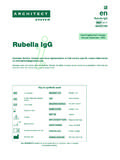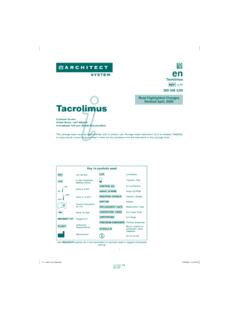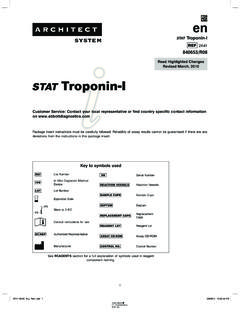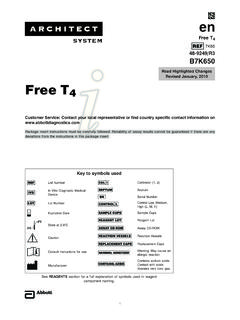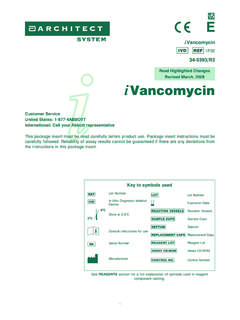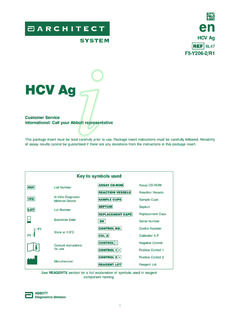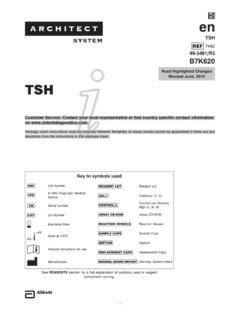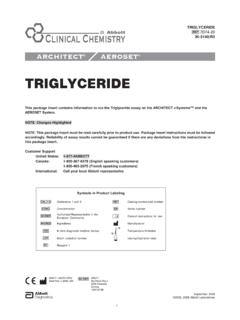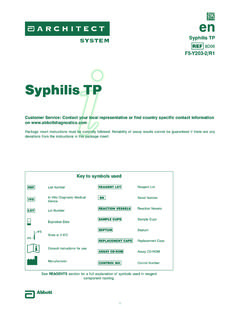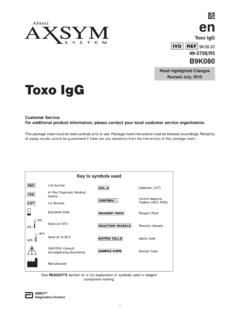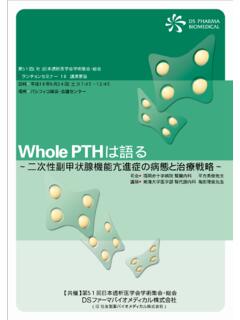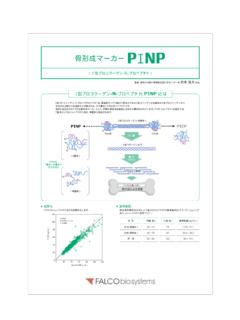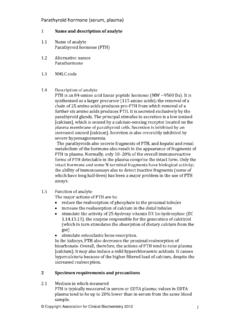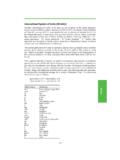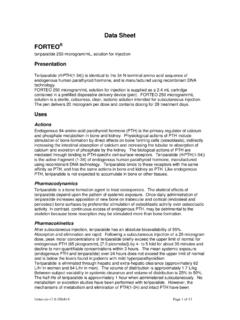Transcription of en - Ilex Medical Ltd.
1 1systemIntact PTHenIntact PTH 8K2584-6434/R5 Customer ServiceUnited States: 1-877-4 ABBOTT International: Call your Abbott RepresentativeThis package insert must be read carefully before product use. Package insert instructions must be carefully followed. Reliability of assay results cannot be guaranteed if there are any deviations from the instructions in this package to symbols usedList NumberIn Vitro Diagnostic Medical DeviceLot NumberExpiration DateStore at 2-8 CConsult instructions for useSerial NumberManufacturerReaction VesselsSample CupsSeptumReplacement CapsReagent LotAssay CD-ROMC ontrol NumberSee REAGENTS section for a full explanation of symbols used in reagentcomponent Highlighted ChangesRevised November, 20082 NAMEARCHITECT intact PTHINTENDED USEThe ARCHITECT intact PTH assay is an in vitro chemiluminescent microparticle immunoassay (CMIA) for the quantitative determination of intact parathyroid hormone (PTH) in human serum and plasma on the ARCHITECT i AND EXPLANATION OF TESTPTH is a single chain polypeptide of 84 amino acids produced by the parathyroid gland.
2 intact PTH1-84 is secreted into the blood stream and undergoes extensive proteolytic modifications. In contrast to its degradation products, the concentration of intact PTH is relatively independent of glomerular filtration rate and reflects the biologically active portion of the primary role of PTH is to regulate the blood calcium level. PTH synthesis and secretion are stimulated within a few minutes by low concentrations of ionized calcium (Cai). The biological activity of PTH is to increase absorption of dietary calcium, decrease renal clearance and mobilize skeletal calcium stores. Abnormally high Cai concentrations suppress secretion of conjunction with serum calcium levels, the PTH assay may be used as an aid in the differential diagnosis of hypercalcemia, hypocalcemia and parathyroid disorders.
3 PTH determination is important in monitoring dialysis patients to manage renal PRINCIPLES OF THE PROCEDUREThe ARCHITECT intact PTH assay is a two-step sandwich immunoassay for the quantitative determination of intact PTH in human serum and plasma using CMIA technology with flexible assay protocols, referred to as Chemiflex. In the first step, sample, assay diluent, and anti-PTH coated paramagnetic microparticles are combined. intact PTH present in the sample binds to the anti-PTH coated microparticles. After washing, anti-PTH acridinium-labeled conjugate is added to create a reaction mixture in the second step. Following another wash cycle, pre-trigger and trigger solutions are added to the reaction mixture. The resulting chemiluminescent reaction is measured as relative light units (RLUs). A direct relationship exists between the amount of intact PTH in the sample and the RLUs detected by the ARCHITECT i System additional information on system and assay technology, refer to the ARCHITECT System Operations Manual, Section KitNOTE: Some kit sizes are not available in all countries.
4 Please contact your local intact PTH Reagent Kit (8K25) 1 or 4 Bottle(s) ( mL each) Anti-PTH (goat, polyclonal) coated microparticles in TRIS buffer. Preservative: sodium azide. 1 or 4 Bottle(s) ( mL each) Anti-PTH (goat, polyclonal) acridinium-labeled conjugate in MES buffer with protein (bovine, goat) stabilizer. Preservative: sodium azide. 1 or 4 Bottle(s) ( mL each) intact PTH Assay Diluent containing phosphate buffer with protein (bovine, goat) stabilizer. Preservative: sodium Diluent ARCHITECT i Multi-Assay Manual Diluent (7D82-50) 1 Bottle (100 mL) ARCHITECT i Multi-Assay Manual Diluent containing phosphate buffered saline solution. Preservative: antimicrobial ReagentsARCHITECT i Pre-Trigger Solution Pre-Trigger Solution containing (w/v) hydrogen i Trigger Solution Trigger Solution containing N sodium i Wash Buffer Wash Buffer containing phosphate buffered saline solution.
5 Preservative: antimicrobial agent. WARNINGS AND PRECAUTIONSFor In Vitro Diagnostic PrecautionsCAUTION: This product requires the handling of human specimens. It is recommended that all human sourced materials be considered potentially infectious and handled in accordance with the OSHA Standard on Bloodborne Biosafety Level 23 or other appropriate biosafety practices4,5 should be used for materials that contain or are suspected of containing infectious agents. This product contains sodium azide. For a specific listing, refer to the REAGENTS section of this package insert. Contact with acids liberates very toxic gas. This material and its container must be disposed of in a safe product not classified as dangerous per European Directive 1999/45/EC as amended - Safety data sheet available for professional user on a detailed discussion of safety precautions during system operation, refer to the ARCHITECT System Operations Manual, Section PrecautionsDo not use reagent kits beyond the expiration not pool reagents within a reagent kit or between reagent loading the ARCHITECT intact PTH Reagent Kit on the system for the first time, the microparticle bottle requires mixing to resuspend the microparticles that have settled during shipment.
6 For microparticle mixing instructions, refer to the PROCEDURE, Assay Procedure section of this package MUST be used to prevent reagent evaporation and contamination, and to ensure reagent integrity. Reliability of assay results cannot be guaranteed if septums are not used according to the instructions in this package avoid contamination, wear clean gloves when placing a septum on an uncapped reagent a septum has been placed on an open reagent bottle, do not invert the bottle as this will result in reagent leakage and may compromise assay time, residual liquids may dry on the septum surface. These are typically dried salts, which have no effect on assay a detailed discussion of handling precautions during system operation, refer to the ARCHITECT System Operations Manual, Section Instructions The ARCHITECT intact PTH Reagent Kit must be stored at 2-8 C in an upright position and may be used immediately after removal from 2-8 C storage.
7 When stored and handled as directed, reagents are stable until the expiration ARCHITECT intact PTH Reagent Kit may be stored on board the ARCHITECT i System for a maximum of 30 days. After 30 days, the reagent kit must be discarded. For information on tracking onboard time, refer to the ARCHITECT System Operations Manual, Section 5. Reagents may be stored on or off the ARCHITECT i System. If reagents are removed from the system, store them at 2-8 C (with septums and replacement caps) in an upright position. For reagents stored off the system, it is recommended that they be stored in their original trays and boxes to ensure they remain upright. If any bottle does not remain upright (with a septum installed) while in refrigerated storage off the system, the reagent kit must be discarded. After reagents are removed from the system, initiate a reagent scan to update the onboard stability of Reagent DeteriorationWhen a control value is out of the specified range, it may indicate deterioration of the reagents or errors in technique.
8 Associated test results are invalid and samples must be retested. Assay recalibration may be necessary. For troubleshooting information, refer to the ARCHITECT System Operations Manual, Section 10. 3 INSTRUMENT PROCEDUREThe ARCHITECT intact PTH assay file (assay number 581) must be installed on the ARCHITECT i System from the ARCHITECT i Assay CD-ROM Addition E before performing the assay. The ARCHITECT intact PTH STAT assay file (assay number 585) must be installed on the ARCHITECT i System with STAT protocol capability from the ARCHITECT i Assay CD-ROM Addition E before performing the Routine assay may not be available on all ARCHITECT i detailed instructions on the assay file installation and on viewing and editing assay parameters, refer to the ARCHITECT System Operations Manual, Section information on printing assay parameters, refer to the ARCHITECT System Operations Manual, Section a detailed description of system procedures, refer to the ARCHITECT System Operations default result unit for the ARCHITECT intact PTH assay is pg/mL.
9 An alternate result unit, pmol/L, may be selected for reporting results by editing assay parameter Result concentration units to pmol/L. The conversion factor used by the system is formula: (Concentration in pg/mL) x ( ) = COLLECTION AND PREPARATION FOR ANALYSISS pecimen TypesThe specimen collection tubes listed below were verified to be used with the ARCHITECT intact PTH assay. Human serum (use of serum separator tubes may result in a decrease in concentration).Human plasma collected in:Lithium HeparinSodium HeparinPotassium EDTAL iquid anticoagulants may have a dilution effect resulting in lower concentrations for individual patient ARCHITECT i System does not provide the capability to verify specimen type. It is the responsibility of the operator to verify that the correct specimen types are used in the ARCHITECT intact PTH Citrate, Sodium Fluoride/Potassium Oxalate, and Ammonium Heparin tubes cannot be used with the ARCHITECT intact PTH ConditionsDo not use specimens with the following conditions:heat-inactivatedpooledgrossly hemolyzed (> 500 mg/dL)obvious microbial contaminationcadaver specimens or any other body fluidsFor accurate results, serum and plasma specimens should be free of fibrin, red blood cells or other particulate matter.
10 Serum specimens from patients receiving anticoagulant or thrombolytic therapy may contain fibrin due to incomplete clot caution when handling patient specimens to prevent cross contamination. Use of disposable pipettes or pipette tips is optimal results, inspect all specimens for bubbles. Remove bubbles with an applicator stick before analysis. Use a new applicator stick for each specimen to prevent cross for AnalysisFollow the tube manufacturer s processing instructions for serum and plasma collection tubes. Gravity separation is not sufficient for specimen thawed specimens thoroughly by low speed vortexing or by inverting 10 times. Visually inspect the specimens. If layering or stratification is observed, continue mixing until specimens are visibly homogeneous. To ensure consistency in results, specimens must be transferred to a centrifuge tube and centrifuged at 10,000 RCF (Relative Centrifugal Force) for 10 minutes before testing if they contain fibrin, red blood cells, or other particulate matter, orthey require repeat clarified specimens to a sample cup or secondary tube for specimens with a lipid layer on the top must be transferred to a sample cup or secondary tube.
